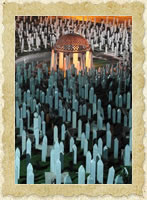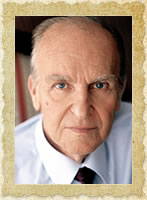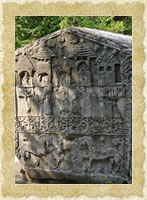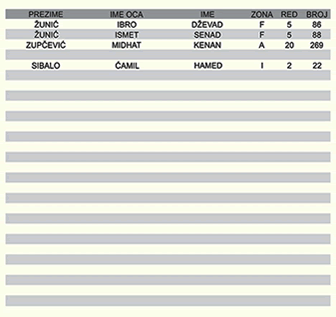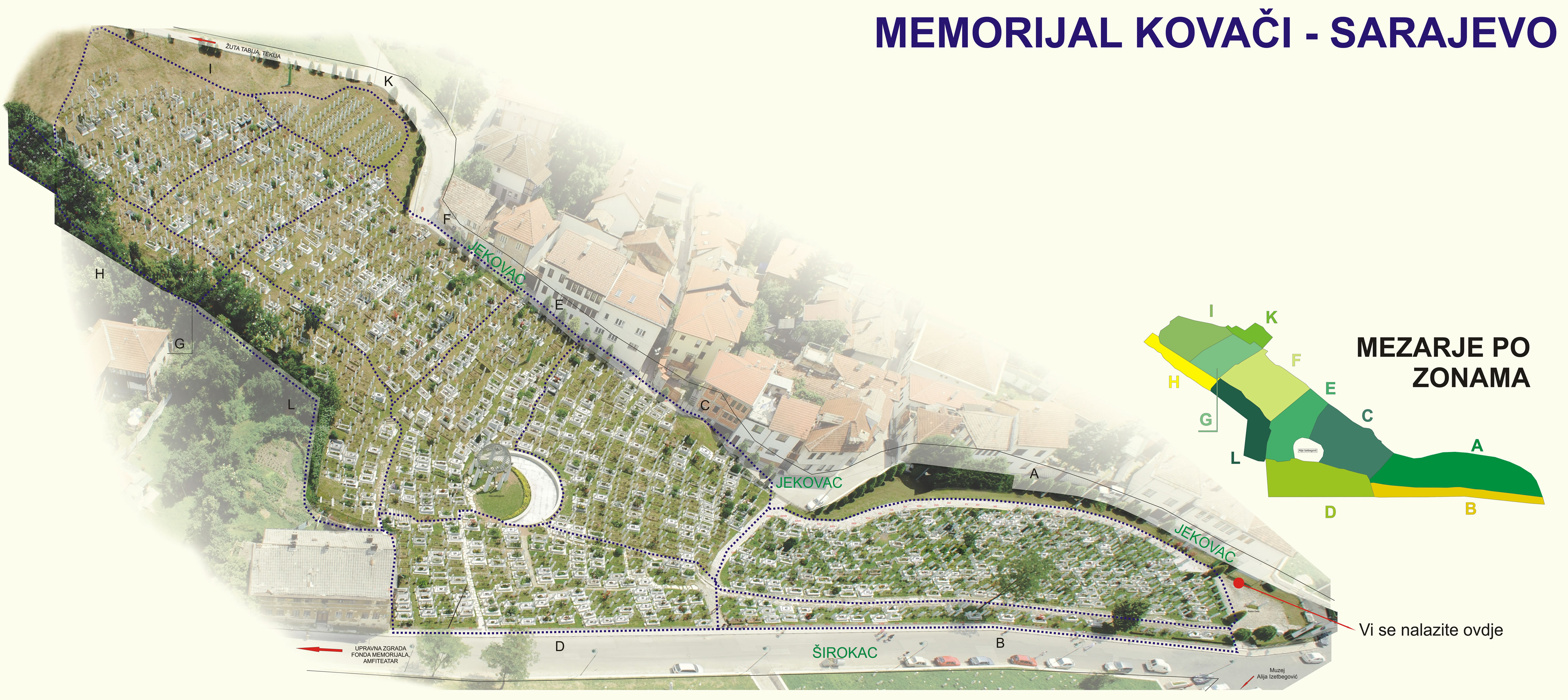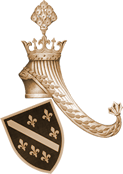 Let It Not Be Forgotten
Memorials Fund
Published in May 2013
Facilitated by
Let It Not Be Forgotten
Memorials Fund
Published in May 2013
Facilitated by
 Municipality of Bursa
Municipality of BursaTurkey
 Municipality of
Municipality of Stari Grad Sarajevo
Memorial Kovači
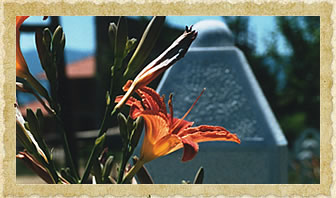
Sarajevo Canton's Fund for Development and Maintenance of War Cemeteries, Memorial Centers and Memorials to Genocide Victims – the Memorials Fund - is a unique administrative institution of this kind in Bosnia and Herzegovina. It was established in 1997 by the Sarajevo Canton Assembly. The core activity of the Fund is construction and placement of headstones on graves of the soldiers killed in the aggression against Bosnia and Herzegovina as well as development, protection and maintenance of war cemeteries.
In the course of its regular activities, the Memorials Fund maintains cooperation with religious communities, war veteran associations, associations of families of killed soldiers, relevant government institutions and non-governmental sector with a view to protecting and preventing destruction of war cemeteries and establishing adequate markings on the graves of killed soldiers. Apart from these activities, the Memorials Fund takes care of appropriate construction works and horticultural content in cemeteries and on individual grave plots of the killed members of the Armed Forces of the Republic of BiH. The Memorials Fund organizes and implements donor conferences in order to raise funds for construction, maintenance and protection of war cemeteries. An important segment in the Fund's activities is organizing meetings and events aiming to raise awareness for fostering the heritage of the 1992-1995 Defence and Liberation War, 1941-1945 National Liberation War and heritage of anti-Fascism, which is the primary task of this institution. Although the Fund was not established at the level of the state of Bosnia and Herzegovina, with the persistence and understanding of other government levels in the Federation of BiH, we managed to persuade the Federation Government and some cantons, cities and municipalities to contribute to the budget of the Memorials Fund, taking thus the leading role in the activities of this type in Bosnia and Herzegovina. Thanks to the perseverance of the Fund's management, numerous projects across Bosnia and Herzegovina have been implemented, in places which are resting grounds of dead fighters for Bosnia and Herzegovina. Preserving the memory of the best sons of our homeland, remembering their great deeds, organizing events to commemorate them and their deeds raises awareness of absolute values of a democratic society: freedom, justice and equality of all peoples on the territory of Bosnia and Herzegovina.
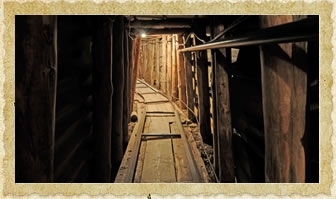
The Memorials Fund works towards revitalizing all memorials, spaces and places testifying to a thousand-year-long struggle for Bosnia and Herzegovina. The ever-present symbol under which all our activities are carried out is a variation of the Bosnian fleur-de-lis as an explicit graphic representation of the statehood of Bosnia and Herzegovina throughout its history.
A silhouette of a headstone with the symbolic fleur-de-lis is the logo of the Memorials Fund. It carries a message and a clear determination to foster a culture of memory and heritage of the Defence and Liberation War 1992-1995. The fleur-de-lis is an obligatory element of all memorials to dead soldiers as an expression of a unique fight of the people of Bosnia and Herzegovina for freedom and independence.
The Fund's mission is defined through three competencies:
Construction and erection of headstones on graves of soldiers killed in the period 1992-1995,
Construction, protection and maintenance of war cemeteries, memorial centers and memorials to genocide victims, and
Fostering the heritage of the Defence and Liberation War 1992-1995 honoring the figure and deeds of dead fighters, National Liberation War 1941-1945 and anti-Fascism.
One of the Fund's important tasks is implementation of the construction project of the Kovači Memorial Center. The Fund carries out the implementation of the planned activities responsibly, in a planned manner and professionally, using its own resources and potentials, with expert staff and adequate technical means.
During its existence, the Fund has realized 421 cemetery development projects and placed 8,779 headstones, of which 341 construction projects and 8,363 headstones in the area of the Sarajevo Canton. In the Federation of BiH, the Fund realized 56 construction projects and placed 324 headstones, and in the RS 24 projects and 92 headstones. The Fund also realized 37 cultural projects (advertising material, CDs, DVDs, publications, books, affiches, documentaries and catalogues of the Memorials Fund), as an expression of fostering the heritage of the Defence and Liberation War 1992-1995.
In parallel to the placement of standardized memorials to the soldiers of the Army of the R BiH in Sarajevo Canton, the Memorials Fund realized a project of placing headstones to killed soldiers in the whole territory of Bosnia and Herzegovina using its own potentials and available resources. Similarly, on the territory of the whole of Bosnia and Herzegovina, the Fund developed cemeteries, built monuments to national heroes (where it was possible considering available space), memorial centers, monuments and honorary public fountains – all in accordance with material and technical capacities of the Fund.
The Memorials Fund wishes to express its most sincere gratitude to all state institutions which provide unselfish support and assistance to the Fund, and in particular to all our donors and well-wishing individuals and organizations who support our activities.
Let us not forget our dead fighters! Because if we forget them we have forgotten ourselves and jeopardize thus our own future and the future of our children.

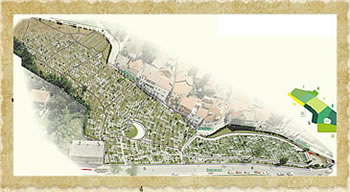 Abaz-Bajrović
Bajrović-Branković
Branković-Čorović
Čosić-Đuzo
Džaferagić-Gerin
Gežo-Haseta
Haseta-Imamović
Imamović-Karamehmedović
Karanović-Kučević
Kučević-Mednolučanin
Medović-Mušić
Mušić-Pindžo
Pindžo-Sačić
Skenderović-Teskeredžić
Šadić-Škamo
Tetarić-Zunđo
Žunić-Sibalo
Abaz-Bajrović
Bajrović-Branković
Branković-Čorović
Čosić-Đuzo
Džaferagić-Gerin
Gežo-Haseta
Haseta-Imamović
Imamović-Karamehmedović
Karanović-Kučević
Kučević-Mednolučanin
Medović-Mušić
Mušić-Pindžo
Pindžo-Sačić
Skenderović-Teskeredžić
Šadić-Škamo
Tetarić-Zunđo
Žunić-Sibalo
“Alije Izetbegović” Museum

The „Alija Izetbegović" Museum was opened on 19 October 2007, exactly four years after the President passed away. It is one of the youngest cultural and historical institutions to be established in BiH. The Museum was originally a branch of the Sarajevo Museums institution, but the Sarajevo Canton Assembly made a decision on 31 December 2009 to make it an independent public institution.This created better opportunities for successful cultural and social work of this institution.
The „Alija Izetbegović" Museum is located in Ploča and Širokac gate-towers, which are parts of the Vratnik Old Town.
This unit has enormous historical value and that was the reason why it was declared a national monument of BiH in March 2005.
The above-mentioned towers house a permanent museum exhibition. The Ploča Tower displays a chronological overview of Alija Izetbegović's life as an ordinary man, politician and statesman, in texts and photographs.The Širokac Tower contains an exhibition dedicated to Alija Izetbegović as the supreme commander and to the organization of defense from the aggression against BiH, as well as to all those who took part in the defense.
The „Alija Izetbegović" Museum is a tribute to a contemporary who dedicated his life and struggle to his homeland and to a better future of the people living in it. The story of the life of Alija Izetbegović, the first president of the independent Republic of BiH, has filled the old stone towers that were empty for centuries, showing thus the continuity of Bosnia. The ramparts and the towers represent a symbol of defense and freedom for which Alija Izetbegović fought his whole life. Therefore, these stone towers containing a museum now have a symbolic meaning because they represent a historical link between the past, present and future.
The Museum is one of the youngest institutions of this type in BiH and does not draw its content from the ancient past. Established in the modern era, the „Alija Izetbegović" Museum gives modern answers to the questions asked in the past, but also provides foundations for the future. With its objective approach, the Museum incites young people, intellectuals, researches ... to write history using their expertise. History, which, judging by the life of Alija Izetbegović, can leave a positive trace only if it is written by the truth.

Alija Izetbegović
08.08.1925. - 19.10.2003Alija Izetbegović was born on August 8, 1925 in Bosanski Šamac. Three
years later, his family moved to Sarajevo. During WWII, Izetbegović
joined the „Mladi Muslimani" /Young Muslims/ organization which mainly
gathered students and had a very strong anti-Fascist and anti-Communist
program. This organization stood up against destruction of religious
institutions and traditional values of the Muslim people in Bosnia and
Herzegovina, which the communists began destroying after they came to
power. After the war, the organization continued to operate and, because
of its activities, came into conflict with the new authorities, which
sparked off arrests of its members. Izetbegović was arrested in 1946 and
was imprisoned until 1949. Upon his release from prison, he resumed his
work with the „Mladi Muslimani", however, the persecution of the
communists became stronger and stronger and many of its members were
condemned to death, so that, eventually, this organization was formally
extinguished. Its idea, however, lived on in informal private
gatherings. He enrolled in the Faculty of Agronomy, which he left after
three years of studies. He graduated later from the Sarajevo Law School
in 1956.
Along with his regular work in a construction company, Izetbegović
followed his other interests in philosophy and literature, global
systems such as communism and capitalism and, of course, Islam and
problems of the Islamic world. In 1969, he drafted and in 1970 completed
and published his „Islamic Declaration". He wrote his book „Islam
Between East and West" in 1946. This best known book of his was later
supplemented and published in 1984 in Canada in English. Because of his
intellectual involvement, communist authorities sentenced him together
with another twelve Bosniak intellectuals, in the well-known „Sarajevo
Process" conducted in 1983, to 14 years of prison. During this rigged
trial, numerous protests and petitions for a release of these prisoners
came from Yugoslavia and the world, including from Predrag Matvejević,
Danilo Kiš, Ciril Zlobec, International PEN Center, Organization of the
Islamic Conference and twenty best known Belgrade-based writers and
academicians. During his prison sentence, he drew strength from his
faith and strong support of his family.
Alija Izetbegović was released from prison in November 1988, after
the Yugoslav Assembly decided to pardon all the prisoners convicted for
verbal offence. The situation in Yugoslavia was much different from that
of several years before: Slovenia and Croatia began demanding
democratization of society and introduction of a multi-party political
system. The Berlin Wall was pulled down soon, the Bolshevik regimes
around the world fell one after another. Alija Izetbegović had no
dilemmas: his goal was a strong political organization of Bosniaks. On
March 27, 1990, a press conference was held to mark the establishment
the Party of Democratic Action (SDA), which opened a process of
democratization of society and introduction of a multi-party system in
Bosnia and Herzegovina. In the inaugural session, Alija Izetbegović was
elected President of the Party. The first multi-party elections were
held on November 18, 1990. The Party of Democratic Action won 86 out of
240 representative seats, and three seats in the seven-member Presidency
of the Republic of Bosnia and Herzegovina. In the inaugural session of
the Presidency of the Republic of Bosnia and Herzegovina, Alija
Izetbegović was elected President of the Presidency. President
Izetbegović regarded the survival and democratization of Yugoslavia a
key element for peaceful resolution of its crisis. Because of that, he
took an active part in the work of the Presidency of the SFRY. These
meetings tried to resolve the fate of Yugoslavia in a peaceful way, but
without success. The last of such attempts was the Platform drafted by
President Izetbegović and the President of the then Republic of
Macedonia, Kiro Gligorov, which stipulated an „asymmetric federation",
in other words, instead of a federal state, Yugoslavia should become a
federation of states. This plan was judged very positively, but it was
destroyed by the destructive political axis Belgrade – Zagreb. Trying to
contribute to a peaceful resolution of the crisis, the Presidency of
Bosnia and Herzegovina, headed by Izetbegović, made a decision that
soldiers and reservists from Bosnia and Herzegovina should not be sent
to the fronts in Croatia.
On December 20, 1991, Bosnia and Herzegovina made a request to the
European Community for recognition of independence and on December 25
that same year it made a decision to hold a referendum on this issue. On
the basis of the European Community's Brussels Declaration dated
December 17, 1991, the Assembly of Bosnia and Herzegovina adopted a
Memorandum of Sovereignty on January 20, 1992. The referendum question
was: „Are you in favor of a sovereign and independent Bosnia and
Herzegovina, a state of equal citizens, peoples of BiH – Muslims, Serbs,
Croats and members of other peoples living in it?". The referendum was
held on February 29 and March 1, 1992, with a 63.95% turnout, of which
99% voted in favor of an independent Bosnia and Herzegovina. Bosnian
Serb leaders contested this referendum. In this dramatic period,
President Izetbegović made his first, but very important, international
contacts. President Izetbegović used all these meetings to emphasize an
urgent need to resolve the crisis on the territory of the whole of
Yugoslavia, in particular in Bosnia and Herzegovina, peacefully.
On the basis of the results of the referendum the European Community
recognized Bosnia and Herzegovina on April 6, 1992, and the United
States of America did the same one day later. On that same day, Bosnian
Serb leader Radovan Karadžić and President of Serbia Slobodan Milošević
launched a military attack on the internationally recognized state of
Bosnia and Herzegovina, including a siege of Sarajevo. Under the very
difficult circumstances of the aggression, the Presidency of Bosnia and
Herzegovina, headed by Alija Izetbegović, made a decision to establish
the Army of the Republic of Bosnia and Herzegovina and a war-time
government. One of the most important decisions that was also made was
that the Presidency should remain in besieged Sarajevo. Alija
Izetbegović worked towards a single, civic, multi-ethnic state of Bosnia
and Herzegovina within its historical borders, and in this sense, he
determined the policy and fight as a liberation war. Returning from
peace talks held in Lisbon on May 2, 1992, together with Prime Minister
Dr Zlatko Lagumdžija and his daughter Sabina, who was the official
interpreter, he was captured at the Sarajevo Airport by the Yugoslav
National Army. This was one of the most dramatic days in Sarajevo, when
the liberation forces fought a decisive battle for the city and for the
state. The Presidency building was held under sniper and artillery fire.
Fifty-seven people were killed in and around the building. Near the end
of the war, this building was also targeted by modified aviation bombs.
Izetbegović, like other Sarajevo citizens, was a continuous target of
artillery fire during the siege of the city. Another heavy blow to the
Republic of Bosnia and Herzegovina during the defensive war was dealt by
President of the Republic of Croatia Franjo Tuđman, who, placing
collaborationist forces from Bosnia and Herzegovina under control of the
Croatian Army, installed a para-military state „Herceg-Bosna", joining
thus the aggression against Bosnia and Herzegovina.
During the aggression against the Republic of Bosnia and Herzegovina and
the genocide against the Bosniaks, President Izetbegović had to make
the most difficult decisions. He participated in all peace negotiations
organized by the international community. Across Europe, in America,
Africa, Asia, in many conferences and meetings he attended, in
particular in the United Nations, he warned of the horrors taking place
in Bosnia and Herzegovina, whose defense efforts were thwarted by the UN
and the most powerful countries of the West by introducing an arms
embargo against this country. Under his chairmanship, the Presidency of
the Republic of Bosnia and Herzegovina, in its capacity of the Supreme
Commander of the Armed Forces, also made important and difficult
decisions, in particular about the development and provision of weapons
for the Army of the Republic of Bosnia and Herzegovina, regardless of
the international illegal embargo. In time, this policy led to a change
of the balance of forces on the battlefields, and thus to strengthening
of negotiating positions of the BiH delegation. As the president of an
internationally recognized state, with international law, justice and
truth on his side, in the course of the war, Izetbegović met nearly
every president or a representative of the western countries. In his
appearances, he was honest and indicated their omissions openly. Still,
their policy of „non-interference" made the defense considerably harder.
In the east, in the Islamic world, he was considered a symbol of a just
fight for Muslims and other anti-Fascists in Bosnia and Herzegovina.
Islamic countries realized that it was the Muslim-Bosniak people that
was most endangered of all in the aggression against Bosnia and
Herzegovina, because this people represented an obstacle to the division
of the country between the neighboring states. Therefore, these
countries were eager to help the just fight of Bosnia and Herzegovina.
President Izetbegović's persistence to prove the truth about Bosnia, the
advancements of the Army of the Republic of Bosnia and Herzegovina on
the battlefields, the weakening morale of the attackers and the genocide
committed in Srebrenica – a UN „safe haven", the Chetnik crime at a
square in Tuzla and at the Markale green market in Sarajevo, and the
ascent to power of new leaders of the leading countries in West Europe
and the USA finally led to an international reaction and military
strikes by NATO on Serb positions in September 1995, which marked the
beginning of the final stages of the war. The war ended with the
initialing of the Peace Agreement in Dayton, Ohio, on 21 November 1995.
The peace negotiations in Dayton were one of the most difficult
moments in President Izetbegović's life. He wrote in his diary: „To
negotiate means to decide, and to decide is the worst job intended for a
human being. My problem was that I could neither win a good peace nor
make a good war". After twenty days of negotiations an agreement was
reached. This agreement confirmed the statehood of Bosnia and
Herzegovina in its historical borders. Peace was signed on 14 December
1995 in Paris. The policy that devastated Bosnia and Herzegovina between
1992 and 1995 continued in a way even after the signing of the Dayton
Agreement. The post-war period brought new difficulties, injustice and
discrimination. Until the end of this political engagement, President
Izetbegović worked towards the strengthening of the state and its
institutions, return of refugees, bringing persons indicted for war
crimes to justice, establishing international cooperation, spreading
human freedoms... Even with failing health, in the following four years,
he made a considerable contribution to the stabilization of the
country. In many international conferences, constantly emphasizing „the
idea of Bosnia" as a planetary challenge to all humanists, he tried in
particular, within his capability, to bring the West closer to the East
and the East to the West. World leaders, associations and media
presented him with numerous awards and recognitions. Due to failing
health, in October 2000 he withdrew from the office of the President of
the Presidency of Bosnia and Herzegovina. One year later, he was elected
honorary life-long President of the Party of Democratic Action.
Historical textbook
" ... hearth of wars and flower among cities, a city of heroes and warriors ... „
These words refer to the Capital of Bosnia and Herzegovina and date back to the 15th century. They were said by the founder of Sarajevo, Gazi Isa-Bey Ishaković. If we look back more than 500 years, these words sound nearly prophetic for the city on the Miljacka River. Hearth as a metaphor of fierce fighting, always defensive, and flower as a metaphor of beauty. They are, at the same time, the best and the most consistent depictions of the city and of the state with whose destiny it is inseparably linked. There is no place on earth where there are over 30 military buildings in one small area, from various eras, and nowhere in the world does a city maternity hospital have a view of 5 out of 150 cemeteries of all confessions of faith, as in Sarajevo. „One does not live here just to live. One does not live here to die. One even dies here to live" (Mehmedalija "Mak" Dizdar, 17 October 1917 – 16 July 1971).
The medieval Bosnian state (Banate and then later Kingdom) lost its independence in 1463, specifically on 5 June, when the last Bosnian king, Stjepan Tomašević, was executed. The conquerors of the Bosnian Kingdom were the Ottomans led by the renowned Sultan Mehmed II (El Fatih), who had captured the capital of the Byzantine Empire – Constantinople ten years before 1453).
Yet, the year 1463 is not the beginning of the Ottoman history of Bosnia. To the contrary. Much before that, the Ottomans had captured a great deal of medieval Bosnia and then established their rule on this territory. This particularly refers to the eastern parts of the Bosnian state, including the territory of today's Sarajevo. Let us note here that this establishment of the Ottoman rule means, among other things, establishment of a completely new cultural and civilizational paradigm which would more or less survive to the present day.
Pre-Ottoman (medieval) Sarajevo
Today's Sarajevo and its surroundings were part of the medieval county of Vrhbosna. At the time of its formation, together with other counties, Vrhbosna was the core of the Bosnian medieval state and was owned by the Bosnian Ban or King. In time, the largest part of the county of Vrhbosna would fall under the feudal family of Pavlović. The center of the Vrhbosna county was a fort (castrum) called Hodidjed. In historical records it is referred to as: Hodidid, Codidich, Codidel, Chodidied, حوديديد...
But, where exactly was the medieval fort of Hodidjed?
Researchers offer various answers or interpretations. For this occasion, we will offer the one presented by Alija Bejtić (1920-1981).
Hodidjed as the center and fortification of the Vrhbosna county was situated at the location of today's Bijela Tabija (White Fort) near Vratnik. Hodidjed as a fort, i.e. castrum, had its town (subcastrum) which was located at the area of today's settlement of Vratnik. The town of Hodidjed had its square in which almost all social events took place. This square was named Tornik or Torkovište. None of this has survived to the present day. The original medieval fort of Hodidjed does not exist any longer. No other medieval building in the area of the Vratnik town has survived. All we can see today in this area dates back to the Ottoman era, which was literally grafted to the Bosnian Middle Ages. But, there is no doubt that remains of old pre-Ottoman structures lie under the foundations of today's buildings in these locations.
Ottoman Sarajevo
Medieval Hodidjed as a town or fort became the first seat of the Ottoman representatives of their supreme power in these parts. Once a medieval county, Vrhbosna would now be renamed after the designation for the Ottoman seat or administrative center – saray (court) - into Sarajevo (Sarajevo-ovasi), meaning: Sarajevo Fields. Only later, when the Ottoman rule was better established, the court or saray would be relocated from the fort Hodidjed downwards and nearer to the Miljacka River. Of course, the fort Hodidjed would always have an important role in the Ottoman Sarajevo, and it would accommodate soldiers led by a „dizdar" or a fort commander. Hodidjed would be remodeled in time several times, and today it bears no resemblance with its structures and form to the medieval fort. The only medieval feature that remained is the concept, visible today.
Vratnik wall, gate-towers and forts – The Ottoman Empire went through an expansion in the 16th century and only towards the end of the 17th and during the 18th centuries it went on a defensive, which was particularly felt in BiH and in Sarajevo. In 1697, Prince Eugene of Savoy broke into Sarajevo with his army and burnt the city almost to its foundations. The arson, pillage and general catastrophe would change the view of the City of Sarajevo, specifically Vratnik, forever. This undesired incident put into motion a whole series of actions with a view to building fortification systems in Vratnik, where Sarajevo citizens could withdraw, protect and defend themselves in case of similar army raids. For this purpose, upon orders by Gazi Ahmed-Pasha Rustempašić Skopljak, the then administrator of Bosnia, a wall was built around Vratnik between 1729 and 1739, incorporating three gate-towers in the wall: Ploča, Širokac and Višegrad Towers. Four forts were also built into the wall: Yellow Fort, Strošić Fort, Arab Fort and Arnaut Fort (the latter two are not available for visits).
The most important of the four forts is the Yellow Fort, also known as the Top-Kula, located at Jekovac. It has a special place in the history of Sarajevo because, during the period of the Austro-Hungarian occupation, under the command of Josip Filipović in 1878, it was here that the defenders of Sarajevo, led by Sheik Muhamed Effendi Hadžijamaković (1814-1878) put up a strong resistance against the occupying forces. Today, during the month of Ramadan, a cannon shot from this tower marks the breaking of the fast.
White Fort , in the 18th century, this fort was joined to the Vratnik fortification system. But, the White Fort originated as an Ottoman expansion of the medieval fortification of Hodidjed. This expansion implied construction of a series of buildings in different time periods, and one of the first buildings to be added to the fort was Sultan Fatih Mosque which we, unfortunately, cannot see today, except its foundations. Still, the final shape was given to this fortification by Austro-Hungarian builders in the 19th century. This fort was also well remembered in the folk tradition by executions of a number of Sarajevo citizens, those who had transgressed against the law or justice. Transgressors or „transgressors" were executed by the „silk rope" and each execution was publicized by cannon fire.
The Waqf Hospital (Hastahana) was the first modern hospital in BiH. It was built with the funds of Gazi Husref-Bey's „waqf" /endowment/ and was formally opened by the Bosnian Vizier Topal Šerif Osman-Pasha on October 8, 1866. The hospital had two wards (men's and women's) with 40 beds and rooms for staff, doctors, pharmacy and sanitary blocks. Treatment in this hospital was free of charge until 1879. In 1891, the first brain surgery in BiH was carried out here by Dr Karl Bayer.
The devastated condition of this building today is the result of the 1992-1995 aggression against BiH in. The building was declared a national monument of BiH and is awaiting reconstruction.
The same Bosnian Vizier, Topal Šerif Osman-Pasha had another hospital built in Sarajevo – Military Hospital (Hastahana). This hospital was built at the same time as the Waqf Hospital but was opened one year later (1868). Today, there is no trace of this hospital, for two reasons:
1. A modern Military Hospital was built on one part of the Ottoman military hospital in the period of the SFRY, 1976-1979. After the aggression, the Military Hospital was reconstructed and works today as the General Hospital „Prim. Dr. Abdulah Nakaš".
2. The last remnants of the Ottoman military hospital were destroyed during the 1992-1995 aggression and the location of this hospital building is a park and children's playground today.
Medžidija Kršla (Barracks) was built in 1854-1856 at Bistrik and is the work of a Macedonian architect Andrija Damjanov. The barracks was originally named after the Ottoman Sultan Abdulmecid. Since its construction to today, the barracks has been used for military purposes, and it was most recorded in the history of Sarajevo in the 90s of the 20th century. This was the barracks that housed the JNA's Second Military District Command and it was this barracks with its command staff that had a key role in the preparation of the aggression against BiH.
Sarajevo in the Austro-Hungarian Period
The 1878 Berlin Congress approved occupation of Bosnia and Herzegovina by the Austro-Hungary – we need to say here that this decision was also supported by the Ottoman Sultan, the ruler of Bosnia at that time! Still, decisions and intentions of Western Europe and the Ottoman Sultan were not binding for the Bosnian people, who would organize themselves quickly and independently and rise against the Austro-Hungarian occupation.
The most tangible and most prominent heritage of the Austro-Hungarian period is their construction and architecture. In this sense, let us emphasize military buildings, singling out the Jajce Barracks which offers one of the best views of the city.
Jajce Barracks was built at Vratnik near the end of the Austro-Hungarian rule in 1914, at a location of a less known barracks which was built in 1886. We know very little about this first barracks. The first name of Jajce Barracks was Prince Eugene of Savoy Barracks, after the name of the same prince who robbed and burnt the City of Sarajevo back in 1697. Still, this barracks would become known as Jajce Barracks during WWI (1915), because the military hospital from the town of Jajce was moved into it.
Jajce Barracks, together with the former Kršla Medžidija Barracks at Bistrik, which would later be renamed into Filipović Barracks, and the Military Camp at Marijin Dvor, belongs to the order of the largest military facilities (complexes) built in the period of Austro-Hungarian administration.
Jajce Barracks was given a new name in 2002 – „Safet Hadžić". However, Sarajevans still know it only as Jajce Barracks!
Unfortunately, Jajce Barracks was devastated in the last war.
Sarajevo Assassination – the end of the Austro-Hungarian rule in BiH - and Sarajevo - began with the First World War. On 28 June 1914, at what is called today Obala Kulina Bana near the Latin Bridge, Gavrilo Princip, a member of the „Young Bosnia" organization shot the Austro-Hungarian heir Franz Ferdinand and his wife Sophia – the shots were fatal and they were both killed. Austro-Hungary accused Serbia of the assassination and on June 10, 1914, a war was declared on Serbia, which officially marked the beginning of the First World War which would last until 1918, when the Austro-Hungarian rule in BiH ceased.
The Lav Cemetery – in the area of Sarajevo's neighborhood of Koševo, during the First World War a military cemetery was established for burials of Austro-Hungarian soldiers. The cemetery was named after a large figure of a lion designed in 1917 by architect Jozef Urban. After WWII, JNA officers were buried in this cemetery, and this lot was named the Partisan Cemetery. The new old name was reinstated in 1992 when the victims of the latest aggression were buried in the cemetery.
Sarajevo Between Two World Wars
After the end of WWI, 1 December 1918, a Kingdom of Serbs, Croats and Slovenes (SHS) was created, comprising Bosnia and Herzegovina, too. This state changed its name on January 6, 1929, into Kingdom of Yugoslavia and this name remained until WWII.In this period, BiH was going through extremely hard and turbulent times. The Agrarian Reform confiscated land – primarily that of Bosniaks of Islamic faith, who were the largest landowners. With further political activities, BiH lost its historical borders in such a way that the then Kingdom of Yugoslavia was divided into banates, i.e. BiH territory was divided between Serbia and Croatia.
War wounds after WWI were hardly healed when another war erupted on the world's scene, in Europe in particular – WWII, in 1939, and the Kingdom of Yugoslavia, i.e. BiH included, becomes a target only in 1941.
Quite soon after the Fascist forces conquered Yugoslavia, BiH was placed under control of the pro-Fascist Independent State of Croatia (NDH). During the war, NDH authorities systematically expelled Jews and Romanies, but also everyone who openly stood against Fascism, ie. all anti-Fascists.
In this period the Fascist Chetnik movement was born, which would carry out unprecedented and formerly unseen crimes against Bosniaks of the Islamic faith, primarily in the areas of Eastern Bosnia.
The City of Sarajevo remembers the Second World War, among other things, by the following date, too:
April 6, 1945 – on this date, Sarajevo was liberated from the Fascist occupiers. On the 5th of April, already, Partisan forces, more precisely, the XVI Muslim Brigade, entered Sarajevo by way of Vratnik (through the Višegrad Gate-Tower), from where other parts of the city were liberated very quickly and on the following day, the 6th of April, Sarajevo was under control of anti-Fascist forces. Once again, like before (1697 or 1878), decisive battles for Sarajevo were fought at or near Vratnik, which, as we said before, is the nucleus of Sarajevo and where Sarajevo is reborn each time from its ashes, like a phoenix.
And for the end, let us say that the Vratnik towers found their place on the Coat of Arms of Sarajevo, and the 6th of April – as the day of liberation from the Fascists – is the Day of Sarajevo.
Places of killings and memorials after WWII – there are many places in and around the City of Sarajevo where Sarajevo citizens were killed and places where memorials were built to resistance and those who were killed by the Fascists. Let us emphasize two:
·Vraca Memorial – above the Sarajevo neighborhood of Grbavica is Vraca, where the Austro-Hungarian authorities, in their times, built quite a big fortress. In this structure, during the Second World War, Nazi forces (and Ustasha) carried out mass executions of Sarajevo citizens. After WWII a Memorial Park was built for the victims of the Fascist terror. Names of thousands of killed citizens of Sarajevo, various ethnicities and religious identities, were inscribed in this Memorial Park.
It is absurd but true that this Austro-Hungarian fortress and Memorial Park to the victims of Fascism from WWII was used by the aggressors during the 1992-1995 aggression as a stronghold for heavy artillery with which they systematically destroyed the city and killed civilians primarily!
·Eternal Flame – after liberation of Sarajevo on the 6th of April 1945 and on the first anniversary after the liberation, a memorial plaque was laid in front of the former Grand Hotel in memory of the liberators of the city and victims of Fascism. A flame was ignited then which has been burning continuously to the present day, except during the siege of Sarajevo, 1992-1995, simply because the city did not have gas in that period.
Sarajevo 1992 – 1995
As a political, administrative, economic and cultural center of Bosnia and Herzegovina, its capital and the largest city, Sarajevo has always been a focus around which all political and military plans for resolution of the fate of Bosnia and Herzegovina were made at the end of the Yugoslav period of its history, from mid-80s to mid-90s of the 20th century. By the brutality of its implementation and the gravity and scope of its consequences, the most important of these plans was the one according to which the Serb political elite defined their exit strategy from the Yugoslav federation. Based on a principle „all Serbs in one state", this plan stipulated disappearance of Bosnia and Herzegovina as a state, achievement of political domination of the Serb ethnic element on the largest part of its territory and joining this territory to the Serb state.

Since this plan could not be realized by political and non-violent means, an important role in the process of its implementation was given to the Yugoslav National Army, whose commanding and managing staff put themselves fully at the service of the Serb political elite. The enormous Yugoslav armed forces were supplemented – in line with subversive anti-Bosnian plans – by the Serbian secret police and its special forces. The broadest support to these forces on the ground in Bosnia and Herzegovina was provided by the Serb Democratic Party (SDS).
On the broader territory of Sarajevo, before March 1992, these structures prepared a terrifying war machine. The war formation of the Sarajevo's 4th Corps of the Yugoslav National Army consisting of 24,000 men was reinforced with volunteer structures consisting of 33,200 men, which the YNA secretly and illegally formed and armed. These forces did not include the structures of the Territorial Defense and parts of the active and reserve police forces which the SDS had withdrawn from the legitimate government structures, as well as various volunteer and special units of Serbia's National Security Services and its derivatives sprung up in the local areas in Bosnia and Herzegovina.
These forces carried out a test of a full blockade of Sarajevo on 1 March 1992 by placing barricades on the city’s thoroughfares after a referendum on independence held by the authorities of Bosnia and Herzegovina on a constitutional basis and upon a request of the arbitration commission of the International Peace Conference on Yugoslavia. The military blockade of Sarajevo was put up on the eve of the recognition of independence of Bosnia and Herzegovina by the European Community on 6 April 1992. This action changed the character of the activities of the Yugoslav armed forces from politically biased and subversive action against the constitutional order of Bosnia and Herzegovina into an act of armed aggression as defined by international law. By the beginning of May, the blockade of the city of Sarajevo was structured into a classic medieval military siege.
The purpose of such large engagement of Serb military and police forces in the area of Sarajevo was articulated on a strategic level and had a twofold character. On the one hand, these activities had a purely military goal – capturing the city, which would end the war quickly and successfully for the attackers. On the other hand, a brutal and anti-civilizational siege of Sarajevo, killings of civilians under everyday activity of Serb forces, permanent creation of humanitarian crises in the city in which the Serb military and political leaderships could continue with manipulation and blackmail, quite successfully tied defense resources and facilitated implementation of Serb strategic goals in other areas of Bosnia and Herzegovina, diverting attention of the international public from the crime of genocide and ethnic cleansing committed in the implementation of these goals.
The aggressor's forces could not take Sarajevo militarily because they could not overcome the resistance of its fighters. The resistance and strength of the fighters – members of the Ministry of Internal Affairs and Territorial Defense and as of July 1992 the Army of the Republic of Bosnia and Herzegovina, although strong from the very beginning because it was based on enthusiasm and heroism of patriots who stood up to defend their city and homeland, still continued to grow. Since the first battles in April and until 1 September 1992 the strength of the defenders of Sarajevo grew to a corps level. With the forces deployed within the city, engaged on its decisive defense and the forces on the external siege ring, the 1 Corps of the Army of the Republic of BiH successfully defended the city of Sarajevo until the end of the war. Apart from the armed battles, in which 5,394 were killed and 20,513 were wounded for the freedom of the city and the state of BiH, the 1 Corps also did its best to provide means of survival for the citizens of Sarajevo in other ways. One of best-known activities of that kind was the digging of a tunnel under the runway of the Sarajevo Airport, which connected Dobrinja and Butmir and which ensured communication and supply of minimum quantities of the most important means for the survival of the city.
On the basis of the Dayton Agreement reached in late 1995, the war in Bosnia and Herzegovina was ended. City areas which were held by the Serbs during the war were reintegrated in the process of the implementation of the Agreement in spring 1996.
Visit...
Vratnik
The neighbourhood of Vratnik is located where Hodidjed (castrum) used to be, below the fort, at the site of a medieval settlement (subcastrum), with a small Ottoman-era business center called Mejdan in its center, built on the site of an old medieval square called Tornik. All this indicates that Vratnik, with its long continuity from the medieval period through the Ottoman period to today, has remained the nucleus of Sarajevo. Vratnik, as a name, has Slavonic etymology. In the areas of Slavonic south, „vratnik" denotes the space through which one enters or exits (door).
Vratnik is a settlement on a slope, with a large plateau in its center called Mejdan and which represents Vratnik's business center, which used to have a number of shops and workshops such as: bakers, barbers, green-grocers, candle-makers, blanket-makers, pot-makers... Even today one can find many general goods shops, catering businesses, etc. Mejdan, which is the „heart" of Vratnik, branches out into many narrow, steep and winding alleys, stairs and often blind alleys. People have been building and destroying things along these „bloodlines" of Vratnik for centuries. And indeed, Vratnik has a rich cultural and historical heritage, primarily sacral and fortification-oriented. Before we list some of the cultural and historical monuments, we need to say that many similar buildings have been lost forever in this area's tumultuous history.
White Mosque – is one of the most beautiful mosques at Vratnik but also in the whole of Sarajevo. It was built in the first half of the 16th century by Hajdar-Effendi. This benefactor was the divan-katib or the secretary to the greatest Sarajevo benefactor and Bosnian Sanjak-Bey Gazi Husref-Bey. The following should be noted here: since Hajdar-Effendi wrote all his working life, he collected the cuttings of his reed pens when he sharpened them and left the following instructions for those who would prepare his body for burial: „When I die, heat the water with which you will wash my dead body on a fire made of these pieces of reeds I collected all my life!". People say that this wish was granted. Hajdar-Effendi died in 1545 on his return from the Hajj. Behind him he left a mosque which the people called White Mosque because it was white-washed to a pearl white color, with no match in Sarajevo. The mosque has a tall and slender stone minaret, and it is specific by its wooden storied entrance domes, which is not customary of Bosnia and Herzegovina mosques. The mosque has a beautiful graveyard with extremely beautiful tombstones in it. The graveyard contains a mausoleum believed to be the grave of the benefactor of this mosque. There is a curiosity related to the tombstone under this mausoleum which is wooden now, but according to a popular legend it was originally made of pure gold before it was taken away by Eugen of Savoy when he raided Sarajevo in 1697 – we repeat here, this is only a legend! The mosque complex also contains a female religious school which was mentioned first in 1697. Next to the mosque was a clock-tower in the 19th century, which was pulled down for security reasons – the local residents thought that it could easily be blown down by the wind and cause serious damage.
Kovači
Below Vratnik, all the way to the main Sarajevo bazaar (Baščaršija) stretches a residential area known as Kovači. The word „kovači" like „vratnik" is a Slavonic word and marks a place where metal or stone is worked – in this case stone! So, the settlement of Kovači had always had master masons who primarily made tombstones. Even in pre-Ottoman and medieval times, the art of making and dressing tombstones was extremely developed. This art would survive the fall of the Bosnian medieval state in a specific way and this specific type of making tombstones for various faiths would continue. The art of tombstone making was reflected later in the making of Islamic tombstones and Christian tombstones, even lions marking the resting places of Jews – primarily Sephardic and later Ashkenazi Jews.
We did not make this small excursion into the art of Bosnian and Herzegovinian tombstones – medieval and modern – for nothing. The reason is obvious, but only if you consider the urban and architectural picture of Kovači. Almost wherever you turn, you will see tombstones – Muslim tombstones. The oldest tombstones at Kovači date back to the 15th century or to the period of the Ottoman conquest of Bosnia. It is these 15th century tombstones that display the tombstone art reflex most visibly– first in the iconography or the plastics of the tombstones. The oldest tombstones are archaic in form, very tall, even exceeding two meters, dressed simply and often without a turban and inscription. They bear symbols almost identical to those from centuries ago, before the Ottomans, which are: semi-spheres (apples), sticks, bows and arrows, sickle moons, hands, etc. These old tombstones have a stelae or obelisk form with pyramidal endings with semi-spheres on top. Tombstones of this type are transitional between the medieval tombstone and what would become later the classic Muslim tombstone. If you look carefully at the tombstones in all four cemetery units we believe you will notice these oldest forms in which you will see the pre-Bosnian Ottoman tradition.
A large number of tombstones at Kovači are linked to various legends about the lives of the persons buried under them. These legends are most often about people who marked the time and space in which they lived. One of the most interesting legends is the one about Hasan-Effendi, better known as Yellow (Sari) Hafiz, who lived in the 18th century. What we know about him is that he was a dervish of the Numanian order and that he cured Sarajevo citizens who thought he was clairvoyant. He died in 1778 and his epitaph was made by the renowned Divan poet Mehmed Mejlija Guranija (1713-1781). This is a part of the epitaph:
„O death,
Ah, sorrow, as Hafiz-Effendi, of angelic virtue,
Moved from this world to an everlasting castle.
He spent his whole life in humility and prayer,
And had no demands in this world.
He had no equal in ascetism and piety in his time,
And is it a miracle if the Lord places him in Paradise.
..."
Let us also note that Sarajevo citizens regard the Yellow Hafiz as an evliya (a saint) and his grave is known even today as a place of blessing and fortune, where you say a prayer when you pass by it.
Apart from graveyards at the area of Kovači, there are other cultural and historical sights, primarily mosques – and one that particularly stands out is Mišćina Mosque. This mosque was built by Kebkebir Hajji-Ahmed in the first half of the 16th century and was named officially after its benefactor. However, in the 18th century, people began calling this mosque Mišćina after the muezzin who was known for his beautiful adhan /call to prayer/, particularly the morning prayer – Sabah. This is what Mula Mustafa Bašeskija of Sarajevo says about this muezzin in his Summer Chronicle: „He would recite praise in the morning and fill the city with his voice". It is known that this muezzin died in 1786/87 and that he was buried in the graveyard right across the mosque. His tombstones are of smaller dimensions and are made of green stone (tufa) without an inscription, and according to tradition his real name was Mehmed and he was a tailor by trade – he made lady waistcoats. But Mišćina Mosque was not only famous for its muezzin Mehmed from the 18th century - this mosque traditionally had muezzins who excelled with their voices, as some say with their „Sarajevo spirit" which was closely linked to the traditional interpretation of the „sevdalinka" /lyric folk song/.
Mišćina Mosque, as an architectural creation, belongs to the group of the most beautiful Sarajevo neighborhood mosques. It has a stone minaret, a hipped roof, a lavishly stalactite-adorned mihrab. But, what singles this mosque out of all other Sarajevo mosques are two paintings on the left wall inside the building. These two color paintings with an interesting perspective, depicting Mecca and Madinah, were painted in 1870 by the painter Mustafa Faginović (Sarajevo about 1793 – Istanbul about 1900), who is also known by his work in the famous Sultan-Fatih Mosque in Istanbul. Many old Sarajevans who did not have an opportunity to carry out their fifth Islamic duty (Hajj - pilgrimage to Mecca) at the time when the Hajj was performed came to Mišćina Mosque and watched the paintings of the two sacred temples and thanks to the symbols of this holy art they made a spiritual connection with the Kaaba in Mecca and the Prophet's grave and mosque in Madinah.
The Balkan Mevlevi Research Center – Isa-Bey Ishaković, considered to be the founder of Ottoman Sarajevo, built, among other things, a famous tekke in the locality of the medieval village of Brodac – centuries later and until the present day this locality would be known as Bendbaša. The tekke was mentioned first in Isa-Bey Ishaković's title deeds dated 1462. Although the document did not specify which order the tekke belonged to, there is a series of historical facts which doubtlessly indicate the Mevelvi order. The tekke had a tumultuous and rich past and an exceptionally important role in the development of the City of Sarajevo. Unfortunately, the tekke was completely destroyed after WWII, in 1958, in the name of a modern urban policy – although it was an architectural pearl, a synthesis of the indigenous Bosnian and Ottoman-Oriental building. Here is a description of Isa-Bey's Tekke from the Seyahatname or pen of the most renowned Ottoman and world travel writer Evliya Celebi (17th century):
„The Mevlevi Tekke is located on the banks of the Miljacka River, on a spot as beautiful as gardens of Eden. It is a waqf-tekke of the order of Celaluddin Rumi. It has a ritual hall for the dervishes (semahane), a conversation room (meydan) and seventy to eighty spacious dervish cells with a gallery, where the dervishes play (mutriban), with a kitchen (imaret) and dining room. Its leader (sheikh )is an educated dervish whose pleas God hears. The leader of its players (nayenzibasa), the calligrapher dervish Mustafa has a beautiful handwriting".
Although Isa-Bey's Mevlevi Tekke was destroyed in the late 50s of the 20th century, Mevlevism in Sarajevo never died out. More or less, it has always been present most frequently in the form of lectures from Mesnevi – a capital work of the spiritual pillar (Qutba) of the Mevlevi order, i.e. Mevlana Celaluddin Rumi (Belhiya).
In 2013, the Mevlevi tradition in Sarajevo received a new dimension with the construction of the Balkans Mevlevi Research Center at Kovači. This center was built following the architectural form of the former Isa-Bey's Tekke at Bendbaša. It is a result of a long friendship between two twinned municipalities: Selcuk Municipality from Konya (Turkey) and Stari Grad Municipality (BiH).
Hopefully, this center as the future Mevlevi tekke, will be a meeting point for those who crave the Spring of Life (abu-haya) where Hidr (a.s.) came – a messenger of God's eternal hierognosis (ma'rifa akhirawiyya). Amen!
 Sebilj – javna česma
Sebilj – javna česma
- je podignut 1753. god. sredstvima bosanskog vezira Mehmed-paše Kukavice. Sebilj je imao burnu povijest, pa je više puta obnavljan. Sadašnji izgled, u neomaurskom stilu, dao mu je 1891. godine arhitekta Josip Vancaš.
 Kazandžiluk, Male daire i Luledžina ulica
Kazandžiluk, Male daire i Luledžina ulica
Čine ambijentalnu cjelinu koja daje sliku stare Baščaršije, onakve kakva je bila prije jedno stoljeće i više. U ulici Kazandžiluk već nekoliko stoljeća njeguje se ručna izrada bakrenog posuđa i drugih predmeta, a u Luledžinoj ulici formiran je mali "trg” oko kojeg su nekada bile daire (kameni magacini za smještaj robe), pa tako i danas imamo sačuvane Male daire.
 Gazi Husrevbegova džamija
Gazi Husrevbegova džamija
 Brusa-bezistan – Muzej grada Sarajeva
Brusa-bezistan – Muzej grada Sarajeva
